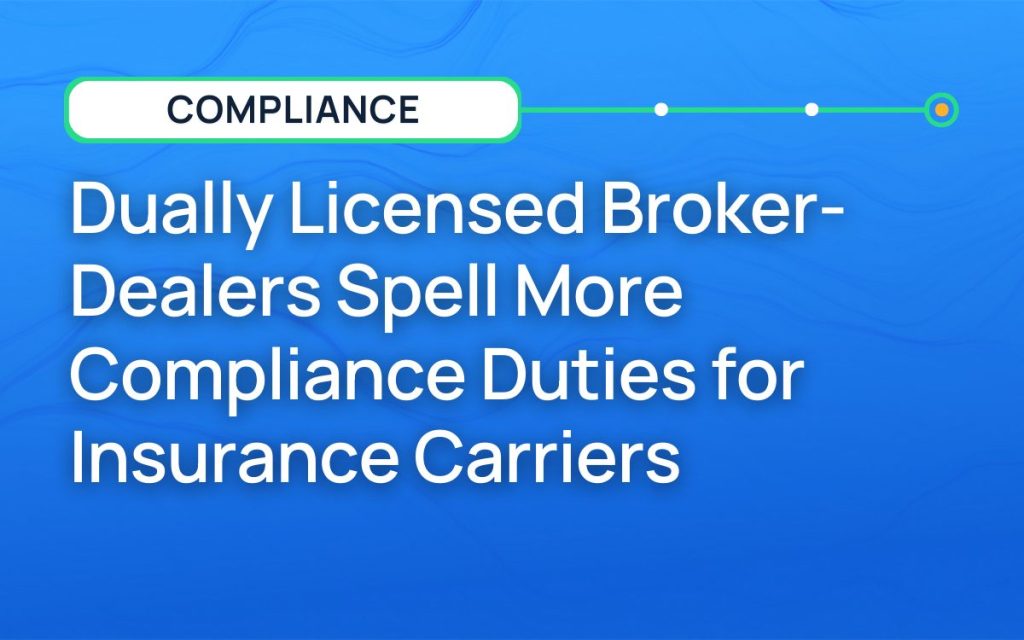Dually Licensed Broker-Dealers Spell More Compliance Duties for Insurance Carriers

Insurance carriers often have their hands full trying to verify and make sure that all of their in-house and external distribution partners are in compliance with every state’s (often unique) insurance regulations. When carriers add variable lines of insurance to the mix, the challenge of doing so is multiplied.
For insurance carriers with dually licensed broker-dealers, whether employed by the carriers themselves or contracted through outside agencies, the compliance bar for selling variable annuities, registered index-linked annuities, or variable life insurance policies is higher than for those selling standard insurance products alone. Not that the compliance bar for insurance carriers is ever low! It’s just that with variable lines of insurance being linked to the riskier securities market, there’s a whole other layer to the compliance cake.
Why is managing broker-dealer compliance so hard?
Broker-dealers are a unique type of insurance sales person who are dually licensed and qualified to sell both traditional life insurance and variable lines of insurance such as variable annuities (VAs) and registered index-linked securities (RILAs). Since insurance is largely regulated on the state level while securities are largely regulated on the federal level, dually licensed broker-dealers are subject to both state and federal laws. It doesn’t help that those state laws often differ from one to another. This means a broker-dealer who sells in both Texas and Arkansas (if not across all 50 states and U.S. territories) has to stay in compliance with different state-by-state life insurance regulations plus federal securities regulations.
Who regulates insurance licenses?
Each U.S. state or territory has a department of insurance, led by an insurance commissioner, tasked with regulating the insurance industry within that state. While there are some federal insurance regulations (most notably the Dodd-Frank act, among others), most of the rules that insurance carriers, agencies, agents, and producers have to follow come from their state. The National Association of Insurance Commissioners (NAIC) works to standardize state-by-state insurance regulations through model legislation, but states still have their unique local flavor for insurance rules.
Who regulates securities licenses?
The Financial Industry Regulatory Authority (FINRA) is the primary regulator within the securities industry. FINRA sets the requirements for people who want to become licensed securities brokers and administers the licensing exams. While there are some small (mostly administrative) exceptions across states, the securities industry is largely regulated on the federal level by FINRA, acting under authority extended to it by the Securities and Exchange Commission (SEC).
Challenges in maintaining broker-dealer compliance
If it were simple and easy for insurance carriers to monitor and maintain broker-dealer compliance for each one of their staff and external broker-dealers, we wouldn’t be having this conversation. Far from easy, insurance carriers face significant challenges, including:
-
Collecting and comparing data across multiple sources
Insurance carriers need to know which of their broker-dealers are licensed to sell insurance and securities, and in which states. They need to know their broker-dealers haven’t done anything that could cause them to lose their insurance or securities licenses. They need to be aware of license renewal dates, continuing education requirements (and who’s fulfilled them, or not), among many other pieces of data.
To accomplish this, insurance carriers may have multiple dedicated full-time employees whose job it is to check and cross-reference state DOI websites, producer databases, FINRA records, background check results, and more. Doing this for one or two broker-dealers may not be that difficult – though still not fun. Doing it at scale, however, is a major headache that costs insurance carriers more in time, money, and risk than it really should.
-
Validating information against a source of truth
Let’s say an insurance carrier does employ one or more people to collect and compare its broker-dealers’ data across multiple sources: What then?
It’s nearly impossible to know if you’ve got accurate and up-to-date information if you don’t know which source is the correct one to compare against. With all the cross-referencing, it’s natural to want to create a “master” document, a spreadsheet perhaps, in which people can combine their findings from across the various sources they’ve mined for broker-dealer license information.
A major problem with this practice is, without real-time updates and integrations, the data is only as accurate as the last time someone verified it. It also matters what source they used to verify it! Some organizations find themselves verifying one internal tracking document against another internal system or document, with no assurance that either one has the most current information.
Human error can also cause problems when your data’s accuracy relies on one or many people inputting it into one or, more likely, many different places. Mistakes are part of being human, and all the more so when someone’s made to do tedious and repetitive work like manually checking broker-dealer compliance status across both insurance and securities licenses and multiple states.
-
Data silos that cause wasted effort and duplicate work
Silos are great for keeping grain airtight; not so much for information or institutional knowledge. Without a single source of truth, it’s inevitable that information silos will form and lead to trouble. Trouble like wasted time, wasted effort, and wasted money, just to name a few.
Just like they sound, information or data silos are internal walls and barriers that keep vital information from reaching everyone who needs it. This can be purely factual information, like when a broker-dealer’s license renews, or it can be institutional knowledge, workflows, and best practices. When teams and departments can’t readily share this information, it’s inevitable that people will duplicate effort and work.
Wasted time and effort aren’t great for an insurance carrier’s bottom line, but they’re also not great for the staff who have to deal with them. Data silos and the frustrations they create can deter fresh talent from entering your organization, particularly when they have a choice to go somewhere that enables them with modern technology instead of expecting them to do automatable tasks by hand.
How to solve broker-dealer compliance challenges
Adopting a modern solution that automates the flow of license- and compliance-related information about every broker-dealer an insurance carrier works with can solve most of these challenges. Automation reduces manual effort, eliminates the majority of risk from human error, provides a much better experience for broker-dealers, and enables staff to spend more time on high-value work instead of chasing paper.
Imagine:
- Broker-dealers enter their own information just once and it populates everywhere.
- Insurance carrier compliance staff can get a full picture of every broker-dealer’s license status, updated daily.
- Staff can look in one place and get both insurance license and security license status updates and compliance red flags for each broker-dealer.
When modern insurance technology connects insurance carriers to a single source of truth about their broker-dealers, allowing them to access real-time information about both insurance licenses and securities licenses, everyone in the distribution channel benefits.
AgentSync makes broker-dealer compliance quick and easy
This may be one of the rare instances where something that sounds too good to be true is, in fact, not. If you’re looking for ways to eliminate the challenges associated with broker-dealer compliance, AgentSync can help.
AgentSync Manage offers enhanced variable insurance support that unifies FINRA and NIPR data into a single profile, providing a consolidated view of broker eligibility for informed decision-making, accelerated onboarding, and compliance. Learn more or contact us for a demo today!

